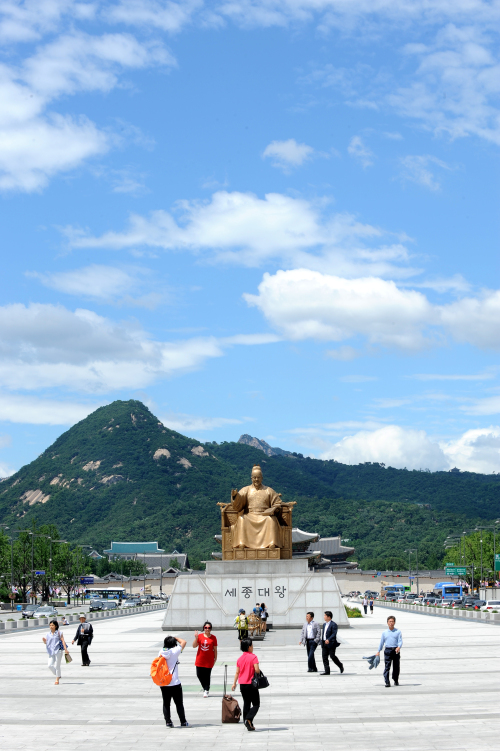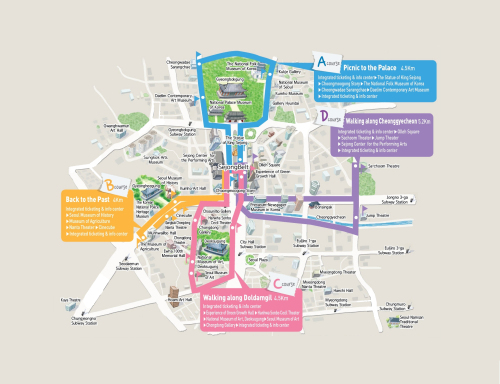Theater buffs can benefit from major discounts for musicals and plays
Everyone loves a good deal Sejong Belt ―a gathering of 47 theaters, museums and cultural organizations around Gwanghwamun Square ― provides just that; a great bargain, well, actually, 32 of them to be exact.
Combo packages offering up to 60 percent off events are, without a doubt, the main attraction of this cultural hub spearheaded by performing arts giant Sejong Center.
Everyone loves a good deal Sejong Belt ―a gathering of 47 theaters, museums and cultural organizations around Gwanghwamun Square ― provides just that; a great bargain, well, actually, 32 of them to be exact.
Combo packages offering up to 60 percent off events are, without a doubt, the main attraction of this cultural hub spearheaded by performing arts giant Sejong Center.

Theatrical performances act as the mainstay of these package deals, with meals, hotel rooms and exhibitions getting thrown into the mix.
For example, couples can check out the musical “Falling for Eve” and dine at Sejong Center’s Gwanghwamun Artee restaurant complex for only 82,000 won; which is 48,000 won less than it would normally cost.
For the month of July alone, there are 32 such packages up for grabs, so which ones are people nabbing?
According to Rhee Ji-hyun, 31, the consulting manager for Sejong Belt’s ticketing and information center, hit packages are ones for the non-verbal cooking performance, Nanta, and the comedic martial arts show, Jump,
“Nanta and Jump are the most popular amongst both Koreans and foreigners,” said Rhee.
Sejong Center’s Sejong Belt PR and marketing employee Shin Ji-young, 26, added that foreigners also like the “Korea with ‘S’” package, which features the musical “Miso” and Seoul Namsan Gugakdang’s cultural experience program, “Misuda.”
What’s more, this discount doesn’t mean you get assigned seating, you can still pick where you want to sit, says Rhee.
Unfortunately, not everything is as flexible.
The meal ticket you get for Artee doesn’t allow you to pick which of the nine places inside the complex you eat at. For example, right now, you can pick from Italian or Chinese, and the meals are set.
Still, a deal is a deal, n’cest-ce pas?
One of the additional bonuses of these packages is that most everything is within a 5-to-20 minute walk from Gwanghwamun Square (where the ticketing center is located), allowing people to visit nearby palaces, museums and other sightseeing hotspots in between events.
While this sort of comprehensive theater bargain may be new here, for anyone who has lived in New York, it is not.
For years, TKTS, the city’s set of famous discount booths, has been doling out Broadway and Off-Broadway show tickets at 20 percent to 50 percent off.
Rhee admits that TKTS did serve as inspiration for the Belt, but their package system takes it a step further by including other aspects as well like exhibitions, meals, hotel rooms and even soccer games.
In addition to their packages, Sejong Belt also sells “rush tickets.”
Rush tickets are sold the day of the actual performance and are half off their original price.
“Tickets go on sale at 10:30 a.m. and can only be purchased at our center,” said Rhee.
In addition to packages and rush tickets, Sejong Belt also offers a program called “Gwanghwamun S-day.”
S-day only happens once a month, on the last Sunday of every month.
A limited number of tickets for 10 to 19 performances go on sale a week in advance for a mere 10,000 won.
A free shuttle that tours Deoksu Palace, Jeong-dong street and other historical and cultural spots also runs on S-day.
As of now, the shuttle tour is conducted in Korean, but Shin says “in the future we will have guides who speak various languages.”
Sejong Belt currently encompasses Gwanghwamun, Jeong-dong, Insa-dong, and Myeong-dong. A few performances are held in Sinchon and Daehangno. Shin says plans are to expand throughout Seoul.
Sejong Belt Integrated Ticketing and Information Center is open from 10:30 a.m. to 8:30 p.m. daily and is located at Gwanghwamun Subway Station Line 5, Exit 9.
Rush tickets need to be purchased at the Ticketing and Information Center. Packages can be purchased online. Plans are to also open a comprehensive site for foreigners soon. Until the site is launched, foreigners can buy packages at the Ticketing and Information Center.
The free shuttle bus departs every 30 minutes from Sejong Center starting at 11 a.m. on “Gwanghwamun S-day.” This month, S-day will be July 31.
For more information call (02) 399-1000 or visit www.sejongbelt.com

Sejong Belt In Depth ― Jeong-dong street
Deoksu Doldam road and Jeong-dong street are both interconnected tree-lined lanes that run up from Deoksu Palace past the Seoul Museum of History and Chongdong Theater.
Famed for their picturesque ambiance and storied legacy, they attract visitors looking for a historic stroll through northern Seoul.
Rumor has it if couples walk along Doldam road they end up breaking up, and, on Jeong-dong street, Korea’s first modern cafe opened in a hotel in 1902.
While you can enjoy Jeong-dong road by taking the free shuttle on “Gwanghwamun S-day,” Sejong Belt package users can just as easily stroll along it before popping into Chongdong Theater to watch “Miso” or into Jeong-dong’s Nanta Theatre to check out “Nanta” (both of which are located there).
Here are a few places to visit on or near Jeong-dong street.
Jeon Kwangsoo Coffee House
It was fate that Jeon Kwangsoo Coffee House opened up an outlet across the street from where Korea’s first cafe once stood.
Jeong-dong shop head Ann Lim, 40, said she was not aware of this at first.
Lim, however, knew of the road’s reputation for being one of the most sought-out strolls in Seoul.
“This street is not bustling or busy, so I felt like it would be a good place to sit back and enjoy a relaxing cup of coffee,” said Lim. “Plus this area is a cultural hub filled with theaters and museums.”
Jeon Kwangsoo Coffee House’s hand-dripped brews, meticulously made by trained baristas, do indeed go perfectly with its culturally rich surroundings.
The establishment also brews some of the best Dutch coffee (cold-brewed coffee) in the city.
Brewed for over 10 hours, the Dutch Coffee Holic No. 1 boasts heady, velvety chocolate aromas, lands round on the tongue and ends with a tannic bite. Served up with ice, it is the perfect antidote to a sultry summer day.
Jeon Kwangsoo’s Jeong-dong outlet is open from 8 a.m. to 11:30 p.m. daily.
Dutch coffee (two varieties) and iced dripped coffee (six varieties) cost 6,500 won. Straight coffee (hand-dripped, 10 varieties) and Jeon’s Blend coffee (3 kinds) costs 5,500 won and is served hot. Espresso blend coffee drinks (hot and iced) cost 4,000 won to 6,000 won. Free refills included.
To get there go to City Hall Station Line 1, 2, Exit 2 and walk down the road between Deoksu Palace and Dunkin’ Donuts. After passing the Seoul Museum of Art, take the middle fork in the road and walk up it. Jeon Kwangsoo is on the left just past Chongdong Theater.
For more information call (02) 752-0289 or visit www.jeonscoffee.co.kr
Deoksu Palace
Deoksu Palace may not be as large and sweeping as Gyeongbok Palace, but it has its own tale to tell.
As the place where Joseon’s 26th monarch ― King Gojong (1852-1919) ― spent his final days, Deoksu bears traces of those turbulent times, of growing Western influences (most apparent in its architecture), and of the end of a dynasty.
A British architect designed the distinctly Grecian-inspired Seokjo-jeon, a white columned building which housed King Gojong’s sleeping quarters.
A Russian architect infused Jeonggwan-heon, a veranda-style structure where King Gojong entertained foreign diplomats and drank coffee, with a charming East-meets-West vibe. Now, every Thursday night at 7 p.m. visitors can enjoy a free traditional Korean music performance there.
Deoksu Palace is open from 9 a.m. to 9 p.m. and is closed Mondays. Admission costs 1,000 won for adults, 500 won for children. Guided tours in English are available. To get there go to City Hall Station Line 1, 2, Exit 2, 12. For more information visit www.deoksugung.go.kr or call (02) 771-9952.
Seoul Museum of History
Though the Seoul Museum of History is not exactly located on Jeong-dong road, it is a six minute walk from Nanta Theatre and a nine minute walk from Gwanghwamun Square, making it worth a stop if heading from the ticketing office to the theatre.
Aside from being air-conditioned (a boon in this hot weather), admission is free.
Visitors can witness the development of Seoul from a Joseon Dynasty capital into the urban destination it is today.
Everything from delicate crafts made by Joseon Dynasty women to a model of the current cityscape is on display.
Children can get a hands-on history lesson on traditional Korean culture at the History Lab Learning Center and Touch Museum stations.
The Seoul Museum of History is open from 9 a.m. to 9 p.m. on weekdays, till 7 p.m. on weekends through October and is closed Mondays. Admission is free. The museum is near Gwanghwamun Station Line 5, Exit 7. For more information visit www.museum.seoul.kr or call (02) 724-0114.
By Jean Oh (oh_jean@heraldcorp.com)









![[Kim Seong-kon] Democracy and the future of South Korea](http://res.heraldm.com/phpwas/restmb_idxmake.php?idx=644&simg=/content/image/2024/04/16/20240416050802_0.jpg&u=)







![[KH Explains] Hyundai's full hybrid edge to pay off amid slow transition to pure EVs](http://res.heraldm.com/phpwas/restmb_idxmake.php?idx=652&simg=/content/image/2024/04/18/20240418050645_0.jpg&u=20240418181020)

![[Today’s K-pop] Zico drops snippet of collaboration with Jennie](http://res.heraldm.com/phpwas/restmb_idxmake.php?idx=642&simg=/content/image/2024/04/18/20240418050702_0.jpg&u=)